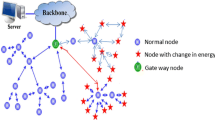Abstract
In recent years, energy consumption and data gathering is a foremost concern in many applications of wireless sensor networks (WSNs). The major issue in WSNs is effective utilization of the resource as energy and bandwidth with a large gathering of data from the monitoring and control applications. This paper proposes novel Bandwidth Efficient Cluster based Packet Aggregation algorithm for heterogeneous WSNs. It combines the idea of variable packet generation rate of each node with random data. The nodes are randomly distributed with different energy level and are equal in numbers. It uses the perfectly compressible aggregation function at cluster head based on the correlation of packets and data generated by each node. Compare to state-of-the-art solutions, the algorithm shows 4.43 % energy savings with reduced packet delivery ratio (62.62 %) at the sink. It shows better bandwidth utilization in packet aggregation than data aggregation.










Similar content being viewed by others
References
Rajagopalan, R., & Varshney, P. K. (2006). Data-aggregation techniques in sensor networks: a survey. IEEE Communications Surveys & Tutorials, 8(4), 48–63.
Krishnamachari, L., Estrin, D., & Wicker, S. (2002). The impact of data aggregation in wireless sensor networks. In Distributed computing systems workshops proceedings, pp. 575–578.
Abbasi, A. A., & Younis, M. (2007). A survey on clustering algorithms for wireless sensor networks. Computer communications, network coverage and routing schemes for wireless sensor, networks, 30(14–15), 15 October 2007.
Pawar, P. M., Nielsen, R. H., Prasad, N. R., Ohmori, S., & Prasad, R. (2012). GCF: Green conflict free TDMA scheduling for wireless sensor network. In 2012 IEEE international conference on communications (ICC), pp. 5726–5730. 10–15 June 2012.
Mantri, D., Prasad, N. R., Prasad, R., & Ohmori, S. (2012). Two Tier Cluster based Data Aggregation (TTCDA) in wireless sensor network. 2012 IEEE international conference on advanced networks and telecommunications systems (IEEE ANTS 2012), pp. 117–122. Bangalore, India, 16–19 Dec. 2012.
Bari, A., Jaekel, A., & Bandyopadhyay, S. (2008). Clustering strategies for improving the lifetime of two-tiered sensor networks. Elsevier, Computer Communication Journal, 3, 3451–3459.
Jung, Woo-Sung, Lim, Keun-Woo, Ko, Young-Bae, & Park, Sang-Joon. (2011). Efficient clustering-based data aggregation in wireless sensor networks. Springer Journal on Wireless Networks, 17(5), 1387–1400.
Mantri, D., Prasad, N. R., & Prasad, R. (2013). Grouping of clusters for efficient data aggregation (GCEDA) in wireless sensor network. 2013 IEEE 3rd international advanced computing conference (IACC-2013), pp. 132–137. Ghaziabad, India, 22–23 Feb. 2013.
Kumar, D., Aseri, T. C., & Patel, R. B. (2011) EECDA: Energy efficient clustering and data aggregation protocol for heterogeneous wireless sensor networks.International Journal of Computers Communications & Control, 6(1), 113–124. ISSN 1841–9836.
Smaragdakis, G., Matta, I., & Bestavros, A. SEP: A Stable Election Protocol for clustered heterogeneous wireless sensor networks. Computer science department, Boston University, Technical, Report BUCS-TR-2004-022.
Mao, Y., Liu, Z., Zhang, L., & Li, X. (2009). An effective data gathering scheme in heterogeneous energy wireless sensor networks. In Proceedings of international conference on computational science and engineering, pp. 338–343.
Gerald, W., Markus, A., & Torsten, B. (2008). MARWIS: A management architecture for heterogeneous wireless sensor networks. WWIC LNCS 5031 (pp. 177–188). Berlin Heidelberg: Springer.
Mantri, D., Prasad, N. R., & Prasad, R. (2013). MHBCDA: Mobility and heterogeneity aware bandwidth efficient cluster based data aggregation for wireless sensor network. 3rd international conference on wireless communications, vehicular technology, information theory and aerospace & electronics systems (VITAE), pp. 1–5. Atlantic City, NJ, 24–27 June. 2013.
Manoj Kumar, S., & Rajkumar, N. (2013). SCT based adaptive data aggregation for wireless sensor networks. In Springer link, wireless personal communications, Oct 2013.
Khan, M. I., Gansterer, W. N., & Haring, G. (2012). Static vs. mobile sink: The influence of basic parameters on energy efficiency in wireless sensor networks. Computer Communications. ISSN 0140–3664, 7 Nov 2012.
Li, S., Da Xu, L., & Wang, X. (2013). Compressed sensing signal and data acquisition in wireless sensor networks and internet of things. IEEE Transactions on Industrial Informatics, 9(4), 2177–2186.
Author information
Authors and Affiliations
Corresponding author
Rights and permissions
About this article
Cite this article
Mantri, D., Prasad, N.R. & Prasad, R. BECPA: Bandwidth Efficient Cluster Based Packet Aggregation in Wireless Sensor Network. Wireless Pers Commun 76, 335–349 (2014). https://doi.org/10.1007/s11277-014-1709-z
Published:
Issue Date:
DOI: https://doi.org/10.1007/s11277-014-1709-z




